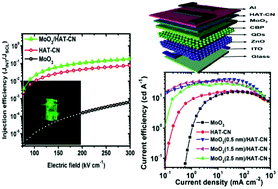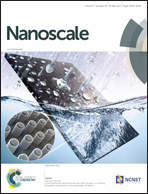High-efficiency inverted quantum dot light-emitting diodes with enhanced hole injection†
Abstract
Hybrid MoO3/HAT-CN is employed as a hole injection layer (HIL) in green inverted colloidal quantum dot light-emitting devices (QLEDs). The hybrid HILs can be easily prepared and have been found to effectively improve the electroluminescent properties. The best performance device had an HIL of 1.5 nm-thick MoO3/2.5 nm-thick HAT-CN and showed a turn-on voltage of 1.9 V, a maximum current efficiency (CEmax) of 41.3 cd A−1, and maximum external quantum efficiency of 9.72%. Compared to the corresponding devices with the single MoO3 or HAT-CN interlayer, the CEmax of the hole-only devices was improved by 1.6 or 1.5 times, respectively. The measured electrical performance shows that hole-only devices with hybrid HILs have a smaller leakage current density at low driving voltage and much enhanced hole injection current than the devices with single interlayers. It indicates that much improved electroluminescent efficiency in green inverted QLEDs with hybrid MoO3/HAT-CN orginates from the significant enhancement of hole injection efficiency and suppression of space charge accumulation in the quantum dot-emitting region due to the improved balance of the charge carriers. The hybrid HILs can be extended to other color inverted QLEDs, which are favorable to achieve bright, highly efficient, and color saturation devices for display applications.



 Please wait while we load your content...
Please wait while we load your content...